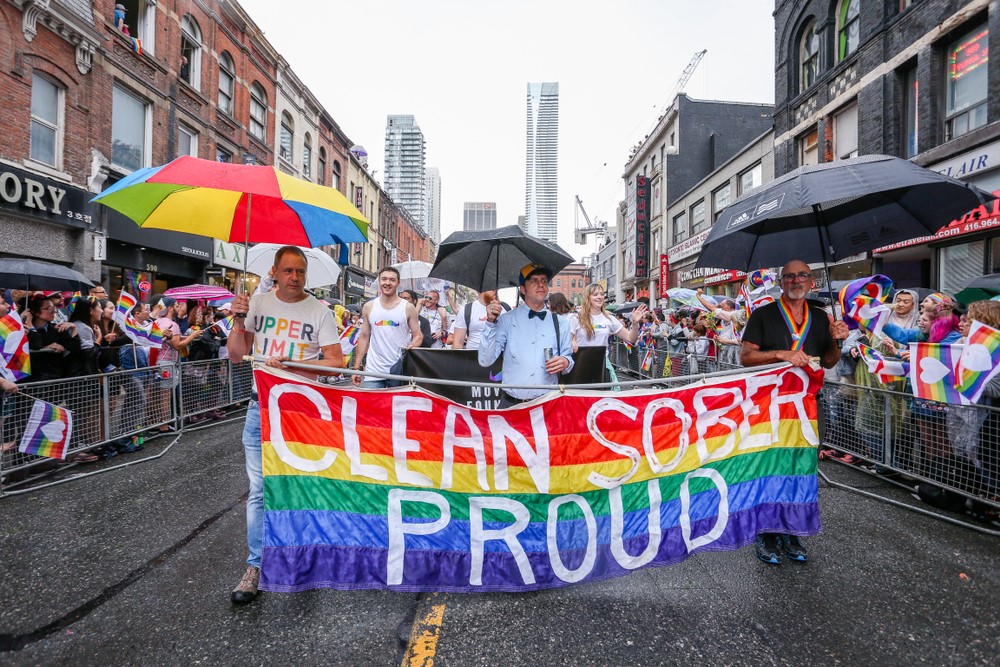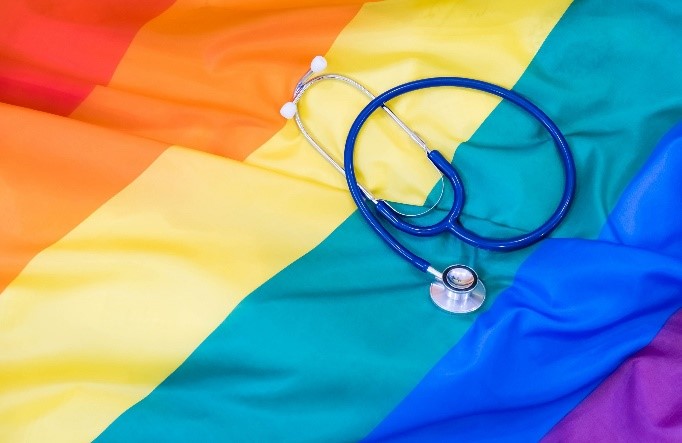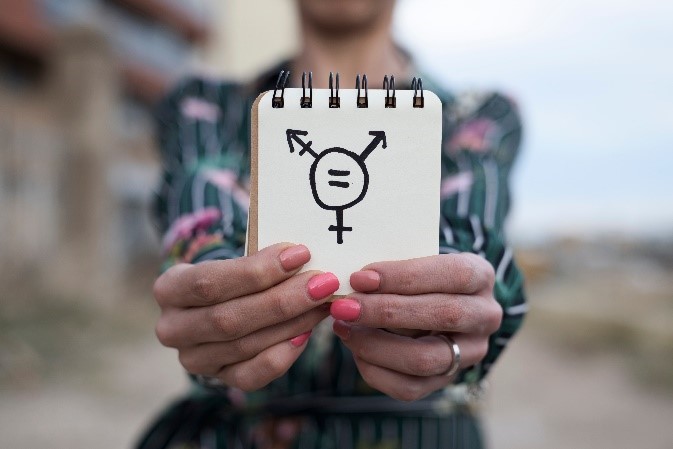
Pride in Recovery II
It begins with euphoria, a relaxed feeling or a sense of grandness and power. It is easy, take a drink, smoke a bowl, snort a line and all is good. it can progress to a sense of being needed to take ‘the edge off’ or get in ‘the right space’ then slowly to a hell of despair.
The party becomes a party of one or an empty shell of its once glittering promise of release and freedom to be who you are without restriction. For too many in the LGBTQ community and others that is the reality of substance use becoming substance abuse becoming an addiction.
It begins with a sense of defeat, a bitter realization that you can’t go on as you are and a feeling that you must break free or be swallowed whole never to return. It is hard, seeking help, being honest about what has happened and how you are feeling to virtual strangers. It progresses to a sense of relief that you are finally doing something to ‘make it right’ and get back to ‘being you’.
The loneliness fades and sense of community with those who understand without judgment and need you as much as you need them makes you feel stronger and better. For so many in the recovering LGBTQ community and others that is the reality of a new life-based in pride.
Written by Michael O’Neal – Clinical Director

The Mental Health Issue’s Men Are Facing
The Mental Health Issue’s Men Are Facing
Men’s mental health is not something we often discuss but it is something that should be made more of a priority, especially since men are more prone to suicide, substance abuse, and they are less likely to seek mental health resources than women. According to psychology today “men make up 75% of suicide victims in the United States.”
While the rate for substance abuse in men is rated 3 to 1 in comparison to females. So, why are men more prone to these things? Well, many men are scared to get help because they fear that they will seem weak and less manly which takes away them since of pride as a man. Another factor psychology today recognized is that “in the current economy, many men are finding it difficult to fulfill a breadwinner role, leaving them without a powerful sense of pride, purpose and meaning in life.”
While previously male’s breadwinner roles were fishing, hunting, and manufacturing, today these options aren’t as available which can hurt a man’s ego. But, another main problem with the men’s suicide rate being so high is because they use substances as a coping mechanism, which is no cure for mental health.
Psychology today refers to substance abuse as “slow motion suicide”, and research suggests that men who abuse substances like alcohol and drugs do so because of life transitions such as death, divorce, unemployment, etc. Which is why men need to seek help for these life transitions.
We need to break the stigma in men’s mental health and make it more normal for men to seek the help they deserve without feeling emasculated for doing so. Many men don’t seek mental health because they don’t want to appear weak or feminine, so they often suffer in silence. It’s time we break the stigma and stand up for men’s mental health.
Resources:
https://www.psychologytoday.com/us/blog/talking-about-men/201702/mens-mental-health-silent-crisis
By: Bella Deen- Marketing Intern

Pride in Recovery
50 years ago, this month the LGBTQ community said “enough.” The 3 days of rioting that followed at the Stonewall Inn still reverberate today.
Much has changed in the intervening years. Psychiatry no longer classifies being LGBTQ as a mental disorder. So-called ‘sodomy laws’ have been declared unconstitutional in the US and marriage for same-sex couples are available in all US states and many countries around the world. Soldiers proudly flood social media with photos of themselves kissing their same-sex partners. The US has a viable and out proud presidential candidate, while two European countries have openly gay men serving as prime ministers.
Much has stayed the same. Many countries in the Middle East, Africa and Asia still practice brutal oppression of people for who they love. The current US administration has banned transgender troops & embarrassingly bigoted ‘bathroom’ bills were the controversy du jour not very long ago.
And substance abuse/addiction still plague the LGBTQ community in higher than average proportions as do mental health issues like depression and anxiety. Fueled by constant exposure to alcohol in the bars and taverns that remain as the chief source of socialization and ready access to methamphetamine and others drugs that are ubiquitous at circuit parties and in the gyms favored by gay men. These substances slowly robbing the souls of those who become trapped by a spiral pride never intended to create.
Depression and anxiety, sometimes created by substances, sometimes by family and religious rejection and sometimes by the drive to be physically ‘perfect’ take their toll too on the mind and spirit. These problems robbing vitality and joy from those who are viewed, if sometimes grudgingly, as the most creative and carefree of peoples.
But here to change for the better is on the horizon. 12 step and other recovery support groups dedicated to the LGBTQ community are found in towns and cities of any size throughout America. As both LGBTQ persons and straight allies age into positions power and professional responsibility, outreach for healing and recovery grows every day. Exult Healthcare is part of that effort… and in that we most definitely take pride.
Written by – Michael O’Neal – Clinical Director of Substance Abuse Services

The Difference Between Sexual Orientation and Gender Identity
The Difference Between Sexual Orientation and Gender Identity
In the LGBTQA community there are many differences in each individual person’s preferences. For example, there is a huge difference between sexual orientation and gender identity. Sexual orientation is who you are attracted to whereas gender identity is who you are. Most people presume that these two things go hand in hand but they are in fact very different.
For example, people may assume that because someone is transgender that they are also gay, which in some cases is not true. Gender identity is defined by the Human Rights Campaign as the “innermost concept of self as male, female, a blend of both or neither – how individuals perceive themselves and what they call themselves.” Which means that people will identify as what fits them the best in their heart and not necessarily what is on the outside.
Whereas sexual orientation is defined as, “inherent or immutable enduring emotional, romantic or sexual attraction to other people.” Meaning who each person is attracted to, who they sleep with, fall in love with, etc. whether they be male, female, bi, gay, straight, lesbian, trans, pan, etc. These are the people they choose to be with and some of the time they do not go hand in hand as most of the population believes that they do.
Being confused about this is a very normal thing, but most people in the LGBTQA community are very nice, understanding, and more than happy to explain the differences to you as well as share their own personal preferences. It is just important to ask and be friendly, because times are changing and it’s important to make everyone feel accepted and loved no matter who they are or who they love.
Written by – Bella Deen – Marketing Intern

Members of the LGBTQ Community and the Healthcare System
I was astounded to find out that there are medical professionals not only treating people for the LGBTQ community differently because of their orientation but also that some of them were being denied treatment outright.
According to “Mental Health America,” Not only are people who identify as a part of the LGBTQ movement have a much higher chance of having a mental illness almost three times more likely. They are also reportedly being turned away from receiving healthcare because of their identity. As many as “8 percent of LGB individuals and nearly 27 percent of transgender individuals report being denied needed health care outright”.
This is horrendous and people, especially people of the LGBTQ movement, need access to healthcare. Especially when considering that these individuals are more likely to have mental Illness and substance abuse problems. as high a rate as 30 percent of LGBTQ youths has a substance abuse problem while compared to as high as 10 percent in the general population.
However, there is a change already happening. In 2011 the Joint Commission “Joint Commission, an independent non-profit national organization that accredits and certifies more than 20,000 health care organizations and programs in the U.S.” They made it a requirement that to be certified that you have to have a nondiscriminatory policy based on one’s sexual orientation, gender identity, and gender expression to be accredited by their organization.
Source
Anon. 2016. “Lesbian/Gay/Bisexual/Transgender Communities and Mental Health.” Mental Health America. Retrieved June 3, 2019
(https://www.mentalhealthamerica.net/lgbt-mental-health).
Written by Jacob Bohn – Healthcare Administration Student

Resources for Adolescents who are Transgender
The term transgender describes an individual whose sense of personal identity and gender does not correspond with their birth sex. A transgender female is a female who was born the sex of a male, however identifies as a female and has made active changes in converting to a female body, through surgery or hormone supplements.
On the GLAAD website, there are many resources listed for transgender individuals including:
- The Trevor Project‘s 24/7/365 Lifeline at 866-4-U-TREVOR (866-488-7386) or Trevor Chat, their online instant messaging option, or Trevor Text, a text-based support option. If you are looking for peer support, you can visit Trevor Spacefrom anywhere in the world.
- The National Suicide Prevention Lifelineat 800-273-TALK (8255)
- Trans Lifelineat 877-565-8860
- Do you live outside the United States? If so, check out The Trevor Project’s list of international resources here.
The GLAAD websites also include a list of trans organizations that supply support and raise awareness for transgender people. Some of the organizations include:
- National Center for Transgender Equality (NCTE)
- Transgender Law Center (TLC)
- Gender Proud
- Sylvia Rivera Law Project (SRLP)
- Transgender Legal Defense and Education Fund (TLDEF)
- Massachusetts Transgender Political Coalition (MTPC)
- Trans People of Color Coalition (TPOCC)
When an adolescent discovers they are transgender, there are many mixed emotions that can follow. Speaking with a licensed therapist can make the transitions and mixed emotions simpler to understand. At Exult Healthcare we respect every person’s sexual identity, and we encourage all those in need to call 469-714-0006 and schedule an appointment today.
Written by Aly Bowles – Social Media Coordinator

5 Ways to Support your LGBTQ Family Members
When a loved one approaches you and tells you that they are gay, bisexual, questioning or a lesbian, a family members first reaction may be excitement, anxiety or anything in between. Some parents and relatives take the news of a child coming out of the closet as alarming, because they themselves have never felt those feelings.
A parent’s confusion can cause a child to feel isolated and alone with their feelings. Not all family members however respond to their children coming out as LGBTQ as a negative. Some parents feel proud of their child and their courage, or feel relieved their child was able to trust them with such a secret. No matter how a parent may feel, these are some beautiful ways to support the family members in your life that are LBGTQ.
- Let them know that they are not alone.
- Show appreciation for the strength and courage it takes to come out.
- Expand your knowledge of LGBTQ issues.
- Understand the importance of your support.
- Don’t try to change your family members sexual orientation or gender identity.
When an adolescent comes out, there are many mixed emotions that can follow. Speaking with a licensed therapist can make the transitions and mixed emotions simpler to understand. At Exult Healthcare we respect every person’s sexual identity, and we encourage all those in need to call 469-714-0006 and schedule an appointment today.
Sources
Caitlin Ryan, David Huebner, Rafael M. Diaz & Jorge Sanchez, Family Rejection as a Predictor of Negative Health Outcomes in White and Latino Lesbian, Gay, and Bisexual Young Adults, 123 Pediatrics 346, 346 (2009).
Caitlin Ryan, Stephen T. Russell, David Huebner, Rafael Diaz & Jorge Sanchez, Family Acceptance in Adolescence and the Health of LGBT Young Adults, 23 J. Child & Adolescent Psychiatric Nursing 205, 210 (2010).
Written by Aly Bowles – Social Media Coordinator

Obsessive Compulsive Disorder
What is Obsessive Compulsive Disorder (OCD)? Many people use the term loosely to describe perfectionistic behaviors. Actually, OCD is characterized by unreasonable thoughts and fears that lead to compulsive behaviors. Researchers have many OCD symptoms into four different types.
- Contamination and washing
- Doubts about accidental harm and checking
- Symmetry, Arranging, Counting, and Just Right OCD
- Unacceptable taboo thoughts and mental rituals
In the past OCD has been treated with medication, talk therapy, or both. For many individuals adjusting the brains chemistry helps to alleviate the obsessions or compulsion, but for some medication was not helpful. But I have great news for individuals whose medication was not effective in treating OCD symptoms. Late last year the FDA approve TMS for treating OCD. TMS is effective in treating OCD because the deep magnetic pulses stimulate neural networks allowing better communication between the neurons. I encourage you to take a couple of minutes to view the video below to better understand how TMS is effective in treating OCD. Please call us to schedule a TMS consultation today!

Borderline Personality Disorder
Border Line Personality Disorder
Border line Personality is a mental health disorder that affects how you feel about yourself and how you react to the world around you. People who have been diagnosed with BPD have patterns of behavior of unstable intense relationships, distorted self-image, extreme emotions and impulsiveness. BDP can only be diagnosed by a Mental Health expert or medical doctor using the DSM-IV (Diagnostic and statistical Manual of Mental Disorders, Fifth Addition).
BPD is not talked about as other mental health disorders. It is estimated that 1.6% of the adult population has BPD, that number may be as high as 5.9%. Nearly 75% of people diagnosed with BPD are women. In recent research suggests that men may be equally affected by BDP but commonly misdiagnosed with Post Traumatic Stress Disorder (PTSD) or depression.
Listed below is the Criteria listed in the DSM-IV used by Mental health experts and medical doctors to diagnose BDP.
A pervasive pattern of instability of interpersonal relationships, self-image, and marked impulsivity beginning by early adulthood and present in a variety of contexts, as indicated by five (or more) of the following:
(1) frantic efforts to avoid real or imagined abandonment.
Note: Do not include suicide or self-mutilating behavior covered in Criterion 5.
(2) a pattern of unstable and intense interpersonal relationships characterized by alternating between extremes of idealization and devaluation
(3) identity disturbance: markedly and persistently unstable self-image or sense of self
(4) impulsivity in at least two areas that are potentially self-damaging (e.g., spending, sex, substance abuse reckless driving, binge eating).
Note: Do not include suicidal or self-mutilating behavior covered in Criterion 5.
(5) recurrent suicidal behavior, gestures, or threats, or self-mutilating behavior
(6) affective instability due to marked reactivity of (e.g., calm intense episodic dysphoria, irritability, or anxiety usually lasting a few hours and only rarely more than a few days)
(7) chronic feelings of emptiness
(8) inappropriate, intense anger or difficulty controlling anger (e.g., frequent displays of temper, constant anger, recurrent physical fights)
(9) transient, stress-related paranoid ideation or severe dissociative symptoms
Do not be discouraged if you have been diagnosed with BPD there is help for you with treatment. Dialectical Behavior Therapy DBT is probably the most common way to treat BPD. DBT is a combination of cognitive and behavioral therapies. The goal of DBT is to transform negative thinking and destructive behaviors and turn them into positive outcomes.
Written by: Piper Kieser – Therapist

Suicide Prevention in Children
Suicide Prevention for Children
Each May we take one day out of the month to bring awareness to children’s mental health, that day is May 9th, while the date has already passed, we would still like to bring a strong since of awareness to this topic. Each year SAMHSA (Substance Abuse and Mental Health Service and Administration) adds a theme to children’s mental health day, this year’s theme is “Suicide Prevention: Strategies that work”.
There are so many strategies that aid in suicide prevention, especially among adolescents. Some of these strategies include, listening to your children even when they aren’t talking, often times most teens or adolescents struggling with suicidal thoughts will often show signs through unusual behavior or actions. Don’t let your child’s depression or anxiety get the best of them! It is important to take suicidal threats seriously and not as children being overdramatic.
Talk about your feelings with your children and let them know they are not alone in this world, because often times they feel like they are totally alone in the world when they are considering suicide. It is important that you be there for them, encourage them to go out and be with friends and family, or to take up a hobby or exercise to decrease they thoughts of suicide.
Finally, it is important to get professional help from a therapist or physiatrist to get your child through these troubling times. Suicide is 100% preventable with the right suicide prevention strategies set in motion. I encourage each one of you reading this to stand up for children’s mental health and suicide prevention among children and teens, not just in the month of May but every day.
Written By: Isabella Deen
References:

